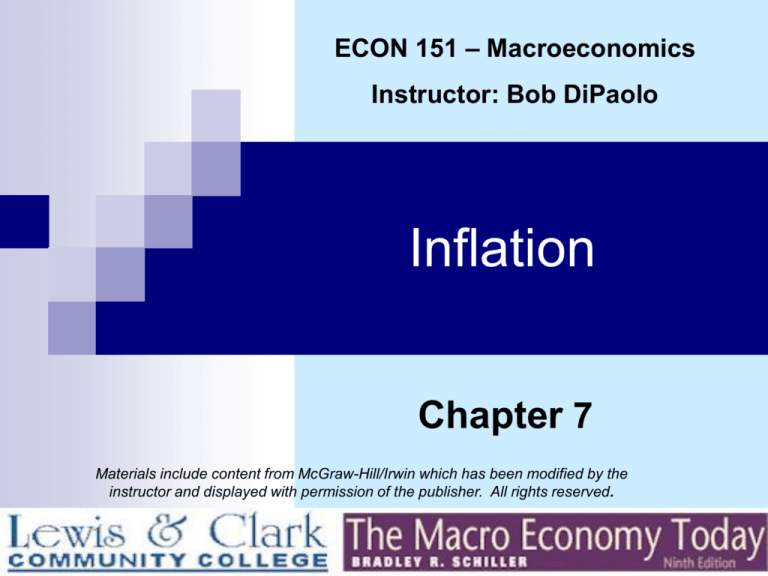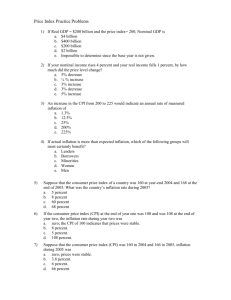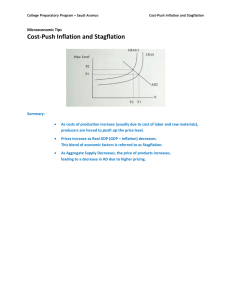
ECON 151 – Macroeconomics
Instructor: Bob DiPaolo
Inflation
Chapter 7
Materials include content from McGraw-Hill/Irwin which has been modified by the
instructor and displayed with permission of the publisher. All rights reserved.
Introduction
In 1923, prices in Germany rose a trillion
times over.
Prices in Russia, Bulgaria, and some other
nations have witnessed a tenfold increase
in a year.
In the 1990’s and early 2000’s the U.S.
inflation rate has risen only 1 to 4 percent
a year.
Introduction
This chapter focuses on the following:
What
kinds of price increases are referred to
as inflation?
Who is hurt (or helped) by inflation?
What is an appropriate goal for price stability?
Inflation is an increase in the average
level of prices, not a change in any specific
price.
A rise
in the average price is called inflation.
A fall in the average price is called deflation.
Relative Prices vs. the Price
Level
A relative price is the price of one good in
comparison with the price of other goods.
By reallocating resources in the economy,
relative price changes are an essential
ingredient of the market mechanism.
A general inflation doesn’t perform this market
function.
Changes in relative prices may occur in a period
of stable average price, or in periods of inflation
or deflation.
Price Effects
Price changes are the most familiar effect
of inflation.
Although inflation makes some people
worse off, it makes some people better off.
The effect on economic welfare is shown
in the difference between nominal and real
income.
Price Effects
Nominal income is the amount of money
income received in a given time period,
measured in current dollars.
Real income is income in constant dollars:
nominal income adjusted for inflation.
Two basic lessons about inflation:
Not all prices rise at the same rate during
inflation.
Not everyone suffers equally from inflation.
Price Changes in 2000
Prices That Rose
(percent)
Gasoline
+28.5
Prices That Fell
(percent)
Coffee
–0.5
Lettuce
+9.5
Video rentals
–1.5
Airfares
+9.4
Women’s dresses
–6.9
Textbooks
+7.0
Oranges
–14.7
Cable TV
+4.8
Computers
–23.2
College tuition
+4.1
Average inflation rate: +3.4%
Income Effects
Even if all prices rose at the same rate,
inflation would still redistribute income.
Redistributive effects originate both in
expenditure and income patterns.
What looks like a price to a buyer looks
like an income to a seller.
If prices are rising, incomes must be rising
too.
Wealth Effects
Winners and losers from inflation depend on
the form of wealth they own.
You lose when inflation reduces the real value
of wealth.
Asset
Percentage change in value:
1984 - 1994
Asset
Percentage change in value:
1984 - 1994
Stocks
326
U.S. farmland
–17
Housing
145
Silver
–12
Bonds
141
Stamps
–8
Gold
–26
Oil
–6
The average price level increased 41%
Redistributions
Inflation acts like a tax, taking income or
wealth from one group and giving it to
another.
The redistributive mechanics of inflation
include price effects, income effects, and
wealth effects.
Price Effects
People who prefer goods and services that are
increasing in price least quickly end up with a
larger share of income.
Income Effects
People whose nominal income rise faster than
inflation end up with a larger share of total income.
Wealth Effects
Owners of assets that increase in real value end
up better off than others.
Social Tensions
Because of redistributive effects, inflation
increases social and economic tensions.
Tensions between labor and management,
between government and the people, and
among consumers may overwhelm a society
and its institutions.
Psychotherapists report that inflation stress
leads to more frequent marital spats, pessimism,
diminished self-confidence, and even sexual
insecurity.
Money Illusion
The use of nominal dollars rather than real
dollars to gauge changes in one’s income or
wealth is called the money illusion.
Even people whose nominal incomes keep up
with inflation often feel oppressed by rising
prices.
They feel cheated when they discover that their
higher nominal wages don’t buy additional
goods.
Macro Consequences
Inflation has macroeconomic effects as
well as the effects on income and wealth
redistribution.
Inflation can alter the rate and mixes of
output by changing consumption, work,
saving, investment, and trade behavior.
Uncertainty
One of the most immediate consequences
of inflation is uncertainty.
Uncertainties created by changing price
levels affect consumption and production
decisions.
Shortened Time Horizons
People tend to shorten their time horizons in the
face of inflation uncertainties.
Time horizons are shortened as people attempt
to spend money before it loses further value.
During the German hyperinflation, workers were
paid two or three times a day so that they could
buy goods in the morning before prices
increased in the afternoon.
Hyperinflation is an inflation rate in excess of
200 percent, lasting at least one year.
Speculation
If you expect prices to rise, it makes sense
to buy things now for resale later.
Few people will engage in production if it
is easy to make speculative profits.
People may be encouraged to withhold
resources from the production process,
hoping to sell them later at higher prices.
As such behavior becomes widespread,
production declines and unemployment
rises.
Bracket Creep
Under our progressive tax system, taxes
go up when prices rise.
Savings, investment, and work effort
decline.
Inflation tends to increase everyone’s
income pushing them into a higher tax
bracket.
Bracket creep is the movement of
taxpayers into higher tax brackets (rates)
as nominal incomes grow.
Deflation Dangers
Deflation — a falling price level — might
not make people happy either.
Deflation reverses the redistributions
caused by inflation.
Lenders win and creditors lose.
When prices are falling, people on fixed
incomes and long-term contracts gain
more real income.
Deflation Dangers
Falling price levels have similar macro
consequences.
Time horizons get shorter.
Businesses are more reluctant to borrow
money or to invest.
People lose confidence in themselves and
public institutions when declining price
levels deflate their incomes and assets.
Consumer Price Index (CPI)
The CPI is the most common measure of
inflation.
The consumer price index (CPI) is a
measure (index) of changes in the
average price of consumer goods and
services.
Consumer Price Index (CPI)
By observing the extent of price increases,
we can calculate the inflation rate.
The inflation rate is the annual
percentage rate of increase in the average
price level.
Constructing the CPI
The Bureau of Labor Statistics constructs a
market basket of goods and services that
consumers usually buy.
Specific goods and services are itemized
within the broad categories of
expenditures.
The CPI is usually expressed in terms of
what the market basket costs in a specific
base period.
Constructing the CPI
The base period is the time period used
for comparative analysis — the basis of
indexing, for example, of price changes.
The relative importance of a product in the
CPI is reflected in its item weight.
Item weight is the percentage of total
expenditure spent on a specific product;
used to compute inflation indexes.
Constructing the CPI
The impact on the CPI of a price change
for a specific good is calculated as follows:
percentage change in CPI =
item weight X percentage change in
price of item
The Market Basket
Transportation
19.0%
Housing
32.6%
Food
13.6%
Insurance and pensions 9.3%
Clothing 4.7%
Entertainment 5.1%
Miscellaneous 10.5%
Health care 5.3%
Producer Price Indexes
There are three producer price indexes
(PPI) which keep track of average prices
received by producers.
One includes crude materials, another
intermediate goods, and the last covers
finished goods.
Producer Price Indexes
PPIs are watched as a clue to potential
changes in consumer prices.
In the short run, the PPIs usually increase
before the CPI.
The PPIs and the CPI generally reflect the
same inflation rate over long periods.
The GDP Deflator:
The GDP deflator is a price index that
refers to all goods and services included in
GDP.
It
is the broadest price index is the GDP
deflator.
It covers all output including consumer goods,
investment goods, and government services.
The GDP Deflator:
The GDP deflator usually registers a lower
inflation rate than the CPI.
Unlike the CPI and PPI, the GDP deflator
is not limited to a fixed basket.
Its value reflects both price changes and
market responses to those changes.
Real vs. Nominal GDP
The GDP deflator is used to adjust nominal
output values for changing price levels.
Nominal GDP is the value of final output
produced in a given period, measured in the
prices of that period (current prices).
Real GDP is the value of final output
produced in a given period, adjusted for
changing prices.
Changes in real GDP are a good measure of
how output and living standards are changing.
Real vs. Nominal GDP
Nominal and Real GDP are connected by
the GDP deflator:
nominal GDP
Real GDP =
GDP deflator
nominal GDP
2000 real GDP =
GDP deflator
$10 trillion
$8.06 trillion
1.24
The Goal: Price Stability
Every U.S. president since Franklin Roosevelt
has decreed price stability to be a foremost
policy goal.
An explicit numerical goal for price stability was
established by the Full Employment and
Balanced Growth Act of 1978.
Price stability is the absence of significant
changes in the average price level; officially
defined as an inflation rate of less than 3
percent.
Unemployment Concerns
Congress chose the 3 percent rate
because of its concern about
unemployment.
The government might have to restrain
spending in the economy to keep prices
from rising.
This could lead to cutbacks in production
and an increase in joblessness.
Unemployment Concerns
A little bit of inflation might be the “price”
the economy has to pay to keep
unemployment rates from rising.
Some unemployment may be the “price”
society has to pay for price stability.
Quality Changes
The CPI is not a perfect measure of
inflation because an increase in price may
caused by quality improvements.
Over time, the goods themselves change
as a result of quality improvements.
New Products
The CPI is biased upward when new
products whose prices are falling are left
out of the market basket.
The Historical Record
In the long view of history, the U.S. has
done a good job in maintaining price
stability.
Upon closer inspection, however, our
inflation performance is very uneven.
The Historical Record
20
Inflation
16
A
12
8
4
B
0
4
8
Deflation
12
1920
1930
1940
1950
1960
1970
1980
1990
2000
Cause: Demand-Pull Inflation
Demand-pull inflation results from
excessive pressure on the demand side of
the economy.
“Too much money chases too few goods”
enabling producers to raise prices.
Cause: Cost-Push Inflation
The pressure on price could also originate
on the supply side.
Higher production costs put upward
pressure on product prices.
Protective Mechanisms
Low rates of inflation don’t have the drama
of hyperinflation, but they still redistribute
real wealth and income.
For
example, if prices rise by an average of
just 4 percent a year, the real value of $1,000
drops to $822 in five years and to only $676 in
ten years.
COLAs
Market participants can protect
themselves by indexing their nominal
incomes.
A COLA protects real income from
inflation.
Cost-of-living adjustments (COLAs) are
automatic adjustments of nominal income
to the rate of inflation.
COLAs are commonly used by landlords
as well as in labor agreements and
government transfer programs.
ARMs
An adjustable-rate mortgage (ARM) is a
mortgage (home loan) that adjusts the
nominal interest rate to changing rates of
inflation.
ARMs were developed to protect lenders
against losses during long term rises in
inflation.
The objective is to maintain a stable rate
of real interest.
ARMs
The real interest rate is the nominal
interest rate minus the anticipated inflation
rate.
Real interest rate = nominal interest rate
– anticipated interest rate
If prices rise faster than interest
accumulates, the real interest rate will be
negative.
The Cost of Mismeasurement
Proliferation of COLAs and ARMs makes
the CPI a critical statistic in today’s
economy.
If CPI goes up, so do government transfer
payments, union wages, and nominal
interest rates.
According to experts, the CPI overstates
inflation by about one percentage point.
Quality improvements, new products, and
changes in expenditure patterns may
cause inflation to be overestimated.
The Cost of Mismeasurement
The CPI’s market basket of goods and
services was overhauled in 1998.
Based on 1993-1995 expenditure patterns,
it included more new products and new
adjustments for quality improvements.
Historical Stability
On the eve of the first world war, prices in Britain
were on average no higher than at the time of
the fire of London in 1666.
During
those 250 years, the longest unbroken run
of rising prices was six years.
Since 1946, by contrast, prices in Britain have
risen every year, and the same is true of virtually
every other OECD country.
Inflation is currently hovering around 3-4%.
The best inflation rate is one that least affects
the behavior of companies, investors, shoppers
and workers.
ECON 151 - MACROECONOMICS
Inflation
End of Chapter 7








